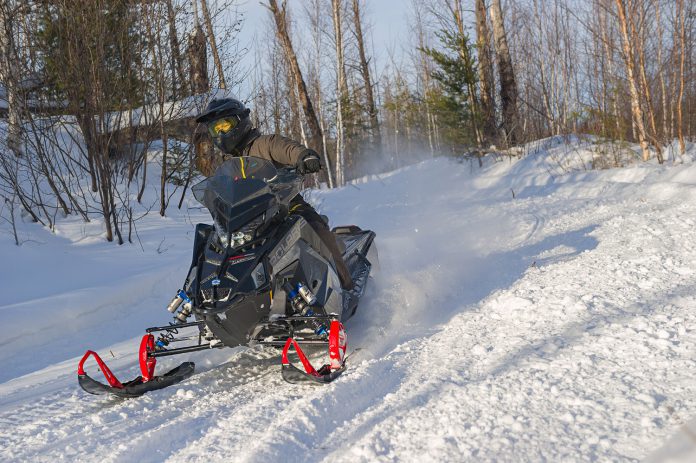Strangely, most snowmobilers who ride trails these days seem to consider a 137-inch track a complete necessity.
It wasn’t long ago the first sleds out the showroom doors were the 120 and 121-inch length models that could pivot on a dime and run whooped-up sections of trail with the skis lightened just by moving your body position a few inches on the seat.
Arctic Cat was first to universally offer a longer 129-incher on its trail models and was eventually followed by every other OEM. This track length offered the best alternative – decent deep snow capability along with almost undetectably compromised turning.
Today, many trail riders deem even a 137-incher is too short to meet their needs. Thus, the newest breed of Crossovers are all equipped with 144 to 146-inch tracks. Has something happened to the trails? Is no one grooming anymore; so everyone has to be ready to ride in powder? Of course not!
What has happened is a giant marketing trend toward convincing the consumer they need to look like a mountain rider.
Back when a 121 was the hot ticket, the buyer image was of a snocross-style or cross-country rider who leapt huge spans of air or ran ungroomed ditches at incredible velocities. This image has worn through considerably the last few years and now average riders see themselves as back-pack wearing, shovel-toting vertical experts – even if they live two thousand miles away from any mountain, let alone one with snow on it. Most don’t even own a back-pack or a shovel.
I know those comments sound pretty harsh – but snowmobile enthusiasm is a constantly evolving phenomenon and it really shows how important it is that potential buyers see themselves a certain way. Does this mean we’re all just a bunch of lemmings hypnotized to do exactly what the OEMs bid us to do?
Honestly, I don’t think so. I think the image has evolved into long tracks mostly because of economics. With the high price of sleds due to the high level of technology they have today – snowmobile consumers simply demand more range from what their sled can potentially offer. Even if a pure trail rider buys a 137 or a 146-inch track and rarely or never goes off-trail with it, at least the potential is there if they ever need to.
Also, viewing things from an economic perspective, whenever it comes time to sell a long tracked sled a few years down the road, the used-sled appeal of a long track will reach far more potential buyers.
Don’t get me wrong – I’m not saying that all trail riders who buy long-tracked sleds are fooling themselves, trying to fit some kind of subliminal image the marketing departments have foisted on them. I personally know a number of long track owners who ride trails and also are very good powder riders, loving nothing more than to take their sleds into the abyss and at least, flatland and foothill ride in the deepest snow they can find. I think those numbers are actually growing.
The other side is, the OEMs have done a fantastic job with the ride and handling of longer sleds. Frankly, we’ve been very pleased to discover how well even a 146 can turn and steer on hardpack compared to a shorter tracked version. Uncoupled suspensions have been tuned and calibrated to the level they perform very close to what a short track can offer.
The simple fact is: There just isn’t much you have to give up by going long.



